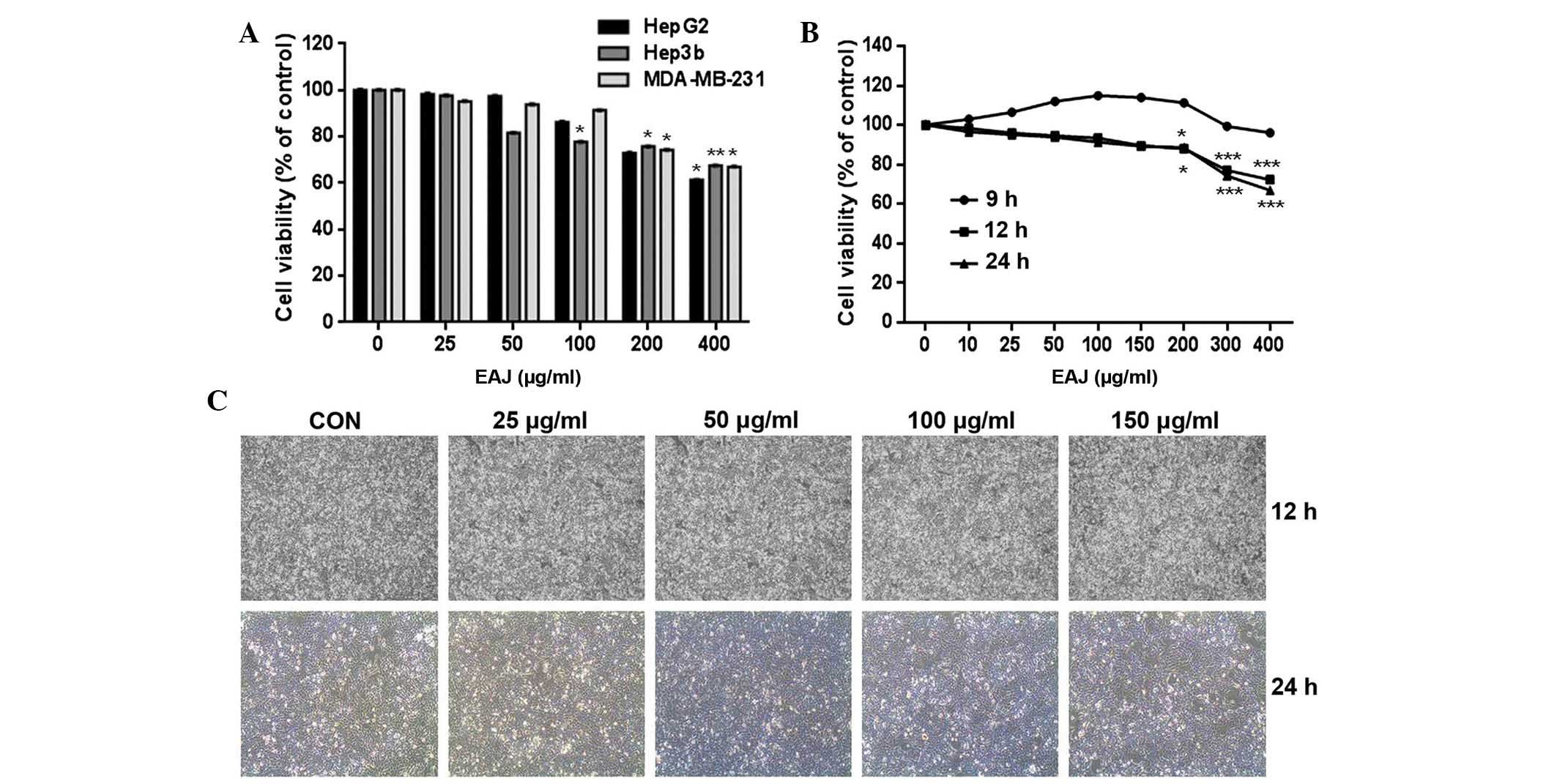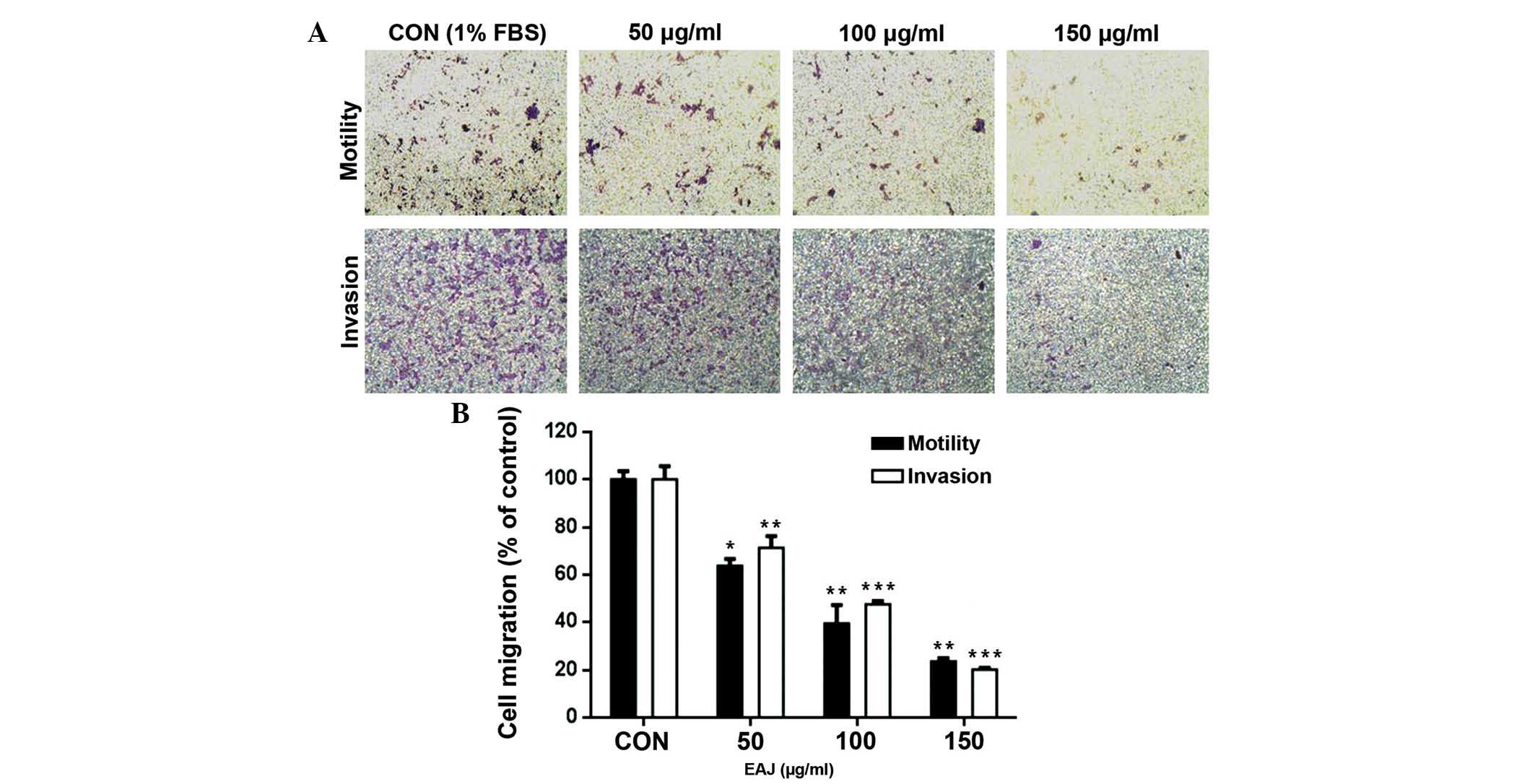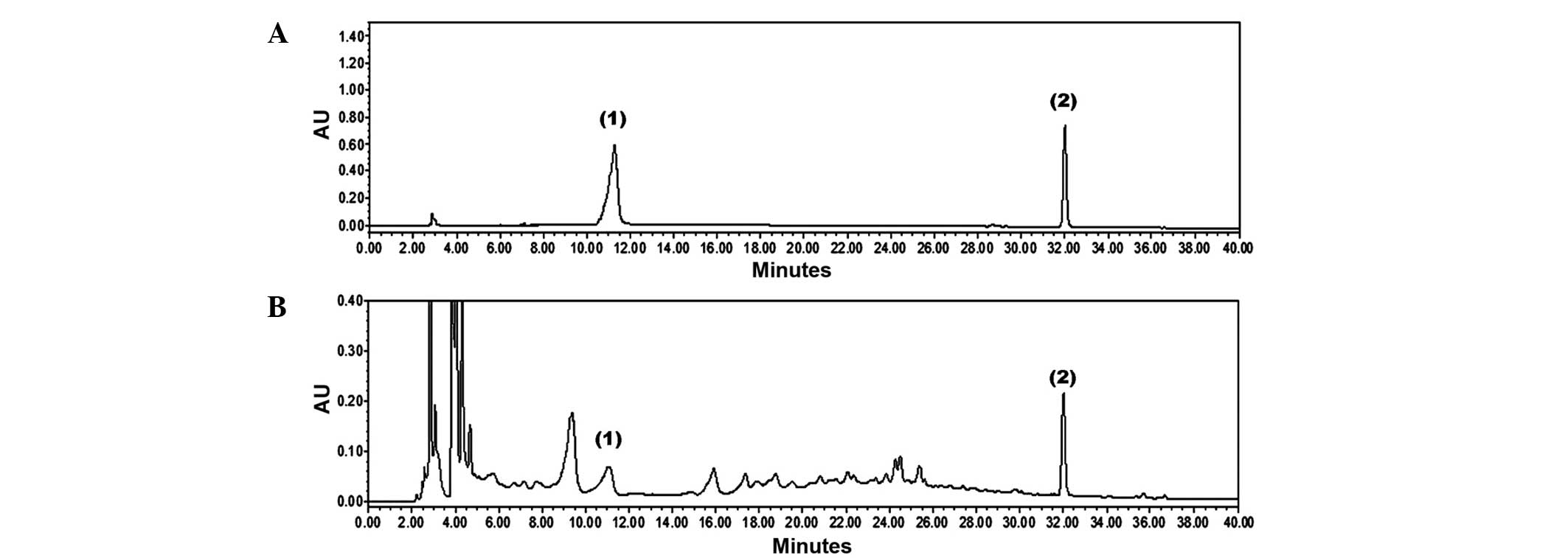|
1
|
Ferlay J, Shin HR, Bray F, Forman D,
Mathers C and Parkin DM: Estimates of worldwide burden of cancer in
2008: GLOBOCAN 2008. Int J Cancer. 127:2893–2917. 2010. View Article : Google Scholar
|
|
2
|
Coughlin SS and Ekwueme DU: Breast cancer
as a global health concern. Cancer Epidemiol. 33:315–318. 2009.
View Article : Google Scholar : PubMed/NCBI
|
|
3
|
Weber GF: Molecular mechanisms of
metastasis. Cancer Lett. 270:181–190. 2008. View Article : Google Scholar : PubMed/NCBI
|
|
4
|
Johansson N, Ahonen M and Kähäri VM:
Matrix metalloproteinases in tumor invasion. Cell Mol Life Sci.
57:5–15. 2000. View Article : Google Scholar : PubMed/NCBI
|
|
5
|
Köhrmann A, Kammerer U, Kapp M, Dietl J
and Anacker J: Expression of matrix metalloproteinases (MMPs) in
primary human breast cancer and breast cancer cell lines. BMC
Cancer. 9:1882009. View Article : Google Scholar
|
|
6
|
Wiwanitkit V: Thai ethnopharmacological
herbs for diabetes treatment: data collection and informatics
tracing for therapeutic property. Diabetes Metab Syndr. 5:103–104.
2011. View Article : Google Scholar : PubMed/NCBI
|
|
7
|
Kim JH, Kim MH, Yang G, Huh Y, Kim SH and
Yang WM: Effects of topical application of Astragalus membranaceus
on allergic dermatitis. Immunopharmacol Immunotoxicol. 35:151–156.
2013. View Article : Google Scholar
|
|
8
|
Han MH, Lee WS, Lu JN, et al: Citrus
aurantium L. exhibits apoptotic effects on U937 human leukemia
cells partly through inhibition of Akt. Int J Oncol. 40:2090–2096.
2012.PubMed/NCBI
|
|
9
|
Mahassni SH and Al-Reemi RM: Apoptosis and
necrosis of human breast cancer cells by an aqueous extract of
garden cress (Lepidium sativum) seeds. Saudi J Biol Sci.
20:131–139. 2013. View Article : Google Scholar : PubMed/NCBI
|
|
10
|
Chang EJ, Lee WJ, Cho SH and Choi SW:
Proliferative effects of flavan-3-ols and propelargonidins from
rhizomes of Drynaria fortunei on MCF-7 and osteoblastic cells. Arch
Pharm Res. 26:620–630. 2003. View Article : Google Scholar : PubMed/NCBI
|
|
11
|
Lu J, Kim SH, Jiang C, Lee H and Guo J:
Oriental herbs as a source of novel anti-androgen and prostate
cancer chemopreventive agents. Acta Pharmacol Sin. 28:1365–1372.
2007. View Article : Google Scholar : PubMed/NCBI
|
|
12
|
Hong CH, Hur SK, Oh OJ, Kim SS, Nam KA and
Lee SK: Evaluation of natural products on inhibition of inducible
cyclooxygenase (COX-2) and nitric oxide synthase (iNOS) in cultured
mouse macrophage cells. J Ethnopharmacol. 83:153–159. 2002.
View Article : Google Scholar : PubMed/NCBI
|
|
13
|
Bae KH: The medicinal Plants of Korea.
Hwang JS: Korea: Kyo-Hak Publishing Co; 328. 2000
|
|
14
|
Suh BI and Jeong GY: Herbology. Lee JG:
Korea: Dae Gu Hanny University; 108. 1987
|
|
15
|
Kim JH, Ju EM, Lee DK and Hwang HJ:
Induction of apoptosis by momordin I in promyelocytic leukemia
(HL-60) cells. Anticancer Res. 22:1885–1889. 2002.PubMed/NCBI
|
|
16
|
Koressaar T and Remm M: Enhancements and
modifications of primer design program Primer3. Bioinformatics.
23:1289–1291. 2007. View Article : Google Scholar : PubMed/NCBI
|
|
17
|
Egeblad M and Werb Z: New functions for
the matrix metalloproteinases in cancer progression. Nat Rev
Cancer. 2:161–174. 2002. View
Article : Google Scholar : PubMed/NCBI
|
|
18
|
Hong S, Park KK, Magae J, et al:
Ascochlorin inhibits matrix metalloproteinase-9 expression by
suppressing activator protein-1-mediated gene expression through
the ERK1/2 signalling pathway: inhibitory effects of ascochlorin on
the invasion of renal carcinoma cells. J Biol Chem.
280:25202–25209. 2005. View Article : Google Scholar : PubMed/NCBI
|
|
19
|
Cairns RA, Khokha R and Hill RP: Molecular
mechanisms of tumor invasion and metastasis: an integrated view.
Curr Mol Med. 3:659–671. 2003. View Article : Google Scholar : PubMed/NCBI
|
|
20
|
Sternlicht MD and Werb Z: How matrix
metalloproteinases regulate cell behavior. Ann Rev Cell Dev Biol.
17:463–516. 2001. View Article : Google Scholar
|
|
21
|
Liotta LA and Stetler-Stevenson WG: Tumor
invasion and metastasis: an imbalance of positive and negative
regulation. Cancer Res. 51(18 Suppl): 5054s–5059s. 1991.PubMed/NCBI
|
|
22
|
Kato Y, Yamashita T and Ishikawa M:
Relationship between expression of matrix metalloproteinase-2 and
matrix metalloproteinase-9 and invasion ability of cervical cancer
cells. Oncol Rep. 9:565–569. 2002.PubMed/NCBI
|
|
23
|
Gilabert-Estellés J, Ramón LA, España F,
et al: Expression of angiogenic factors in endometriosis:
relationship to fibrinolytic and metalloproteinase systems. Hum
Reprod. 22:2120–2127. 2007. View Article : Google Scholar : PubMed/NCBI
|
|
24
|
Weng CJ, Yang YT, Ho CT and Yen GC:
Mechanisms of apoptotic effects induced by resveratrol,
dibenzoylmethane and their analogues on human lung carcinoma cells.
J Agric Food Chem. 57:5235–5243. 2009. View Article : Google Scholar : PubMed/NCBI
|
|
25
|
Roy S, Sannigrahi S, Majumdar S, Ghosh B
and Sarkar B: Resveratrol regulates antioxidant status, inhibits
cytokine expression and restricts apoptosis in carbon tetrachloride
induced rat hepatic injury. Oxid Med Cell Longev. 2011:7036762011.
View Article : Google Scholar : PubMed/NCBI
|
|
26
|
Johnson WD, Morrissey RL, Usborne AL, et
al: Subchronic oral toxicity and cardiovascular safety pharmacology
studies of resveratrol, a naturally occurring polyphenol with
cancer preventive activity. Food Chem Toxicol. 49:3319–3327. 2001.
View Article : Google Scholar
|
|
27
|
Szekeres T, Saiko P, Fritzer-Szekeres M,
Djavan B and Jäger W: Chemopreventive effects of resveratrol and
resveratrol derivatives. Ann NY Acad Sci. 1215:89–95. 2011.
View Article : Google Scholar : PubMed/NCBI
|
|
28
|
Fabre KM, Saito K, DeGraff W, et al: The
effects of resveratrol and selected metabolites on the radiation
and antioxidant response. Cancer Biol Ther. 12:915–923. 2011.
View Article : Google Scholar : PubMed/NCBI
|
|
29
|
Scarlatti F, Sala G, Somenzi G, Signorelli
P, Sacchi N and Ghidoni R: Resveratrol induces growth inhibition
and apoptosis in metastatic breast cancer cells via de novo
ceramide signaling. FASEB J. 17:2339–2341. 2003.PubMed/NCBI
|
|
30
|
Kundu JK and Surh YJ: Cancer
chemopreventive and therapeutic potential of resveratrol,
mechanistic perspectives. Cancer Lett. 269:243–261. 2008.
View Article : Google Scholar : PubMed/NCBI
|
|
31
|
Castillo-Pichardo L and Dharmawardhane SF:
Grape polyphenols inhibit Akt/mammalian target of rapamycin
signaling and potentiate the effects of gefitinib in breast cancer.
Nutr Cancer. 64:1058–1069. 2012. View Article : Google Scholar : PubMed/NCBI
|
|
32
|
Islam S, Nasrin S, Khan MA, et al:
Evaluation of antioxidant and anticancer properties of the seed
extracts of Syzygium fruticosum Roxb. growing in Rajshahi,
Bangladesh. BMC Complement Altern Med. 13:1422013. View Article : Google Scholar : PubMed/NCBI
|
|
33
|
Yu Y, Deng Y, Lu BM, Liu YX, Li J and Bao
JK: Green tea catechins: a fresh flavor to anticancer therapy.
Apoptosis. 19:1–18. 2014. View Article : Google Scholar
|















